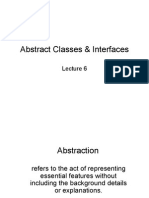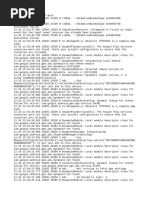04 OOP InterfacesAndInheritance
04 OOP InterfacesAndInheritance
Uploaded by
Víctor Iván González GuevaraCopyright:
Available Formats
04 OOP InterfacesAndInheritance
04 OOP InterfacesAndInheritance
Uploaded by
Víctor Iván González GuevaraOriginal Description:
Copyright
Available Formats
Share this document
Did you find this document useful?
Is this content inappropriate?
Copyright:
Available Formats
04 OOP InterfacesAndInheritance
04 OOP InterfacesAndInheritance
Uploaded by
Víctor Iván González GuevaraCopyright:
Available Formats
Object-Oriented Programming
Lecture 4: Interfaces & Inheritance
Dr. L H!ng Ph"#ng -- Department of Mathematics, Mechanics and Informatics, VNUH
July 2012
1
Tuesday, July 31, 12
Content
Interfaces Inheritance
Defining an interface Overriding and hiding
methods
Implementing an interface
Polymorphism
Using an interface as a type
Object as a super class
Rewriting interfaces
Final classes and methods
Abstract methods and classes
Tuesday, July 31, 12
Defining an interface
public interface GroupedInterface extends Interface1, Interface2, Interface3 {
// base of natural logarithms
double E = 2.718282;
// method signatures
void doSomething(int i, double x);
int doSomethingElse(String s);
}
If an interface is not declared public, it will be accessible only to
classes defined in the same package as the interface.
A class can extend only one other class, an interface can extend any
number of interfaces.
An interface can also contain constant declarations.
3
Tuesday, July 31, 12
Implementing an interface
public interface Relatable {
public int isLargerThan(Relatable other);
}
public class Person implements Relatable {
double weight;
public Person(double w) {
}
weight = w;
Implement the
public double getWeight() {
return weight;
required method
}
public int isLargerThan(Relatable other) {
Person person = (Person) other;
if (this.getWeight() < person.getWeight())
return -1;
else if (this.getWeight() > person.getWeight())
return 1;
else
}
return 0; Note the casting
}
4
Tuesday, July 31, 12
Implementing an interface
public class RectanglePlus implements Relatable {
int width = 0;
int height = 0;
Point origin;
public RectanglePlus(Point p, int w, int h) {
origin = p;
width = w;
height = h; Implement the
}
public int getArea() { required method
return width * height;
}
public int isLargerThan(Relatable other) {
RectanglePlus otherRect = (RectanglePlus) other;
if (this.getArea() < otherRect.getArea())
return -1;
else if (this.getArea() > otherRect.getArea())
return 1;
else
return 0;
}
}
5
Tuesday, July 31, 12
Using an interface as a type
An interface is a reference data type.
If you define a reference variable whose type is an interface, any object
you assign to it must be an instance of a class that implements the
interface.
public Object findLargest(Object object1, Object object2) {
Relatable obj1 = (Relatable)object1;
Relatable obj2 = (Relatable)object2;
if ((obj1).isLargerThan(obj2) > 0)
return object1;
else
return object2;
}
Tuesday, July 31, 12
Rewriting interfaces
Consider an interface that you have developed called DoIt:
public interface DoIt {
void doSomething(int i, double x);
int doSomethingElse(String s);
}
Suppose that at a later time, you want to add a third method to DoIt:
public interface DoIt {
void doSomething(int i, double x);
int doSomethingElse(String s);
boolean didItWork(int i, double x, String s);
}
Tuesday, July 31, 12
Rewriting interfaces
If you make this change, all classes that implement the old DoIt
interface will break because they dont implement the interface
anymore.
Programmers rely on this interface will protest loudly.
You should create a DoItPlus interface that extends DoIt:
public interface DoItPlus extends DoIt {
boolean didItWork(int i, double x, String s);
}
Now users of your code can choose to continue to use the old interface
or upgrade to the new one.
Tuesday, July 31, 12
Another example of interfaces
/** Describes any class whose objects can be measured. */
public interface Measurable {
/**
* Computes the measure of the object.
*
* @return the measure
*/
double getMeasure();
}
/** Describes any class whose objects can measure other objects. */
public interface Measurer {
/**
* Computes the measure of an object.
*
* @param anObject the object to be measured
* @return the measure
*/
double measure(Object anObject);
}
9
Tuesday, July 31, 12
Content
Interfaces Inheritance
Defining an interface Overriding and hiding
methods
Implementing an interface
Polymorphism
Using an interface as a type
Object as a super class
Rewriting interfaces
Final classes and methods
Abstract methods and classes
10
Tuesday, July 31, 12
Inheritance
A class that is derived from another class is called a subclass (also a derived
class, extended class, child class).
The superclass is also called base class or parent class.
In Java, excepting Object, every class has one and only one direct
superclass (single inheritance).
A subclass inherits all the members (fields, methods, and nested classes)
from its superclass.
Constructors are not members, so they are not inherited by subclasses.
But the constructor of the superclass can be invoked from the subclass.
11
Tuesday, July 31, 12
The Java platform class hierarchy
java.lang.Object is the
base class of all Java
objects.
Classes near the bottom
of the hierarchy provide
more specialized
behavior.
12
Tuesday, July 31, 12
An example of inheritance
class MountainBike extends Bicycle {
// new fields and methods defining
// a mountain bike would go here
MountainBike has the same fields
and methods as Bicycle.
13
Tuesday, July 31, 12
class Bicycle {
The fields represent the
int cadence = 0; objects state.
int speed = 0;
int gear = 1;
void changeCadence(int newValue) {
cadence = newValue;
}
void changeGear(int newValue) {
The methods define its interaction
gear = newValue;
} with the outside world.
void speedUp(int increment) {
speed = speed + increment;
}
void applyBrakes(int decrement) {
speed = speed - decrement;
}
void printStates() {
System.out.println("cadence:" + cadence + " speed:" + speed + " gear:"
+ gear);
}
}
14
Tuesday, July 31, 12
An example of inheritance
public class MountainBike extends Bicycle {
public int seatHeight;
public MountainBike(int startHeight, int startCadence,
int startSpeed, int startGear) {
super(startCadence, startSpeed, startGear);
seatHeight = startHeight;
}
public void setHeight(int newValue) {
seatHeight = newValue;
}
}
15
Tuesday, July 31, 12
Inheritance
A subclass inherits all the public and protected members of its parent, no matter what
the package the subclass is in.
If the subclass is in the same package as its parent, it also inherits the package-private
members of the parent.
If you declare a field in the subclass with the same name as the one in the
superclass --> hide it (not recommended)
If you write a new instance method that has the same signature as the one in the
superclass --> override it.
If you write a new static method that has the same signature as the one in the
superclass --> hide it.
Use the keyword super to invoke the constructor of the superclass.
16
Tuesday, July 31, 12
Private members in a superclass
A subclass does not inherit the private member of its parent class.
However, if the superclass has public or protected methods for
accessing its private fields, they can be used to access these fields.
A nested class has access to all the private members of its enclosing
class--both fields and methods.
Therefore, a public or protected nested class inherited by a subclass
has indirect access to of the private members of the superclass.
17
Tuesday, July 31, 12
Casting objects
The object myBike is of type MountainBike:
MountainBike myBike = new MountainBike();
MountainBike is descended from Bicycle and Object:
A MountainBike is a Bicycle and is also an Object.
Casting shows the use of an object of one type in place of another type.
Object obj = new MountainBike();
Implicit casting: obj is both an Object and a MountainBike.
if (obj instanceof MountainBike) {
Explicit casting: MountainBike myBike = (MountainBike)obj;
} 18
Tuesday, July 31, 12
Overriding and hiding methods
An instance method in a subclass with the same signature and return type
as an instance method in the superclass overrides the superclass method.
This allows a class to inherit from a superclass whose behavior is
similar and then to modify behavior as needed.
Use @override annotation to instruct the compiler (optional).
If a subclass defines a class method with the same signature as a class
method in the superclass, the method in the subclass hides the one in the
superclass.
Note that the access modifier for an overriding method can allow more,
but not less, access than the overridden method.
19
Tuesday, July 31, 12
Overriding and hiding methods
public class Animal {
public static void testClassMethod() {
System.out.println("The class" + " method in Animal.");
}
public void testInstanceMethod() {
System.out.println("The instance " + " method in Animal.");
}
}
public class Cat extends Animal {
public static void testClassMethod() {
System.out.println("The class method" + " in Cat.");
}
public void testInstanceMethod() {
System.out.println("The instance method" + " in Cat.");
}
public static void main(String[] args) {
Cat myCat = new Cat();
Animal myAnimal = myCat;
Animal.testClassMethod();
myAnimal.testInstanceMethod();
} The class method in Animal.
} The instance method in Cat. 20
Tuesday, July 31, 12
Polymorphism
Subclasses of a class can define their own unique behaviors and yet
share some of the same functionality of the parent class.
Suppose that we have a base class Person and three subclasses
Vietnamese, English and French.
public class Person { class English extends Person {
public void sayHello() { @Override
System.out.print("I will say: "); public void sayHello() {
} super.sayHello();
} System.out.println("Hello!");
}
}
class Vietnamese extends Person {
@Override class French extends Person {
public void sayHello() { @Override
super.sayHello(); public void sayHello() {
System.out.println("Xin cho!"); super.sayHello();
} System.out.println("Bonjour!");
} }
} 21
Tuesday, July 31, 12
Polymorphism
public class TestPerson {
public static void main(String[] args) {
The Java virtual machine calls the
Person p0, p1, p2; appropriate method for the object
p0 = new Vietnamese();
p1 = new English();
that is referred to in each variable.
p2 = new French();
p0.sayHello(); This is virtual method invocation, an
p1.sayHello();
p2.sayHello(); important aspect of polymorphism.
}
}
I will say: Xin cho!
I will say: Hello!
I will say: Bonjour!
22
Tuesday, July 31, 12
Object as a superclass
java.lang.Object is the root class of all the classes.
Some important methods of Object that we may want to inherit:
protected Object clone() throws CloneNotSupportedException;
public boolean equals(Object obj);
protected void finalize() throws Throwable;
public int hashCode();
public String toString();
23
Tuesday, July 31, 12
Writing final classes and methods
You can declare some or all of a classs methods final.
This indicates that the method cannot be overridden by subclasses.
You make a method final if it has an implementation that should not be changed and
is critical to the consistent state of the object.
class ChessAlgorithm {
enum ChessPlayer {WHITE, BLACK}
//...
final ChessPlayer getFirstPlayer() {
return ChessPlayer.WHITE;
}
//...
}
Methods called from constructors should be declared final.
Final classes cannot be subclassed.
24
Tuesday, July 31, 12
Abstract methods and classes
An abstract class is a class declared abstract. It may or may not include
abstract methods.
Abstract method: abstract void moveTo(double deltaX, double deltaY);
If a class includes an abstract method, that class must be abstract:
public abstract class GraphicObject {
// declare fields
// declare non-abstract methods
abstract void draw();
}
If a subclass of an abstract class does not provide implementations for all
abstract methods in its parent class, it has to also be declared abstract.
25
Tuesday, July 31, 12
Abstract class versus interfaces
Unlike interfaces, abstract classes can contain fields that are not static
and final and they can contain implemented methods.
Interfaces: full abstraction
Abstract class: partial abstraction
Abstract classes are most commonly subclassed to share pieces of
implementation.
26
Tuesday, July 31, 12
An abstract class example
In an object-oriented drawing application, you can draw many different
graphic objects.
They all have certain states (position, orientation, line color, fill color...) and
behaviors (moveTo, rotate, resize, draw...).
Some of these states and behaviors are the same for all objects: position,
fill color, moveTo.
Some require different implementations: resize, draw.
27
Tuesday, July 31, 12
An abstract class example
abstract class GraphicObject { class Circle extends GraphicObject {
int x, y; void draw() {
// ... //...
void moveTo(int newX, int newY) { }
//... void resize() {
} //...
abstract void draw(); }
abstract void resize(); }
}
class Rectangle extends GraphicObject {
void draw() {
//...
}
void resize() {
//...
}
}
28
Tuesday, July 31, 12
Reference
The Java Tutorial
Trail: Learning the Java language
http://docs.oracle.com/javase/tutorial/java/TOC.html
29
Tuesday, July 31, 12
Exercise
Exercise 1. Consider the Card, Deck and DisplayDeck classes that you
wrote in a previous exercise (previous lectures).
What Object methods should these classes override?
Override these methods with suitable implementation.
Exercise 2. See the file 04-OOP-Exercises.pdf.
30
Tuesday, July 31, 12
You might also like
- Courier Management System Project in PythonDocument6 pagesCourier Management System Project in PythonJeeva SadhasivamNo ratings yet
- Java Programming: PolymorphismDocument30 pagesJava Programming: PolymorphismNics BalanayNo ratings yet
- 03 OOP ClassesAndObjects ContinuedDocument25 pages03 OOP ClassesAndObjects ContinuedVíctor Iván González GuevaraNo ratings yet
- Lec23-Interface ClassComparable InterfaceDocument25 pagesLec23-Interface ClassComparable InterfaceHla HakimNo ratings yet
- Topic 4 Polymorphism and InterfacseDocument44 pagesTopic 4 Polymorphism and InterfacseRAROSS KAMILLAH RASITNo ratings yet
- JavaClass - Lecture6 - Abstract Classes & IntDocument27 pagesJavaClass - Lecture6 - Abstract Classes & Intapi-3751900No ratings yet
- Chapter 13-OOP (Additional) V2Document56 pagesChapter 13-OOP (Additional) V2Hai Kim SrengNo ratings yet
- OOP Chapter 3Document60 pagesOOP Chapter 3Abdex AliyiNo ratings yet
- SOLIDDocument31 pagesSOLIDhanspeterkrustyNo ratings yet
- Abstract Classes Interfaces Interfaces: Lecture 08Document19 pagesAbstract Classes Interfaces Interfaces: Lecture 08Sarge ChisangaNo ratings yet
- Lec 23Document32 pagesLec 23vamsi.d124No ratings yet
- Session 7: Methods Strings Constructors This InheritanceDocument16 pagesSession 7: Methods Strings Constructors This InheritanceyekychNo ratings yet
- Lecture 7bDocument137 pagesLecture 7bRuben KempterNo ratings yet
- Lec21-Polymorphism and CastingDocument21 pagesLec21-Polymorphism and CastingHla HakimNo ratings yet
- Oop JavaDocument358 pagesOop JavaAnjali SinhaNo ratings yet
- UNIT 2 JavaDocument91 pagesUNIT 2 JavaSanjay DahalNo ratings yet
- Bindings and Coupling in Java: InstructorDocument15 pagesBindings and Coupling in Java: InstructorTed MosbyNo ratings yet
- WT Lecture-6 (Interface & Packages)Document36 pagesWT Lecture-6 (Interface & Packages)शून्य अद्वैतNo ratings yet
- 02 OOP ClassesAndObjectsDocument31 pages02 OOP ClassesAndObjectsVíctor Iván González GuevaraNo ratings yet
- C++ Lecture NoteDocument8 pagesC++ Lecture NoteMAYOKUN SOFOWORANo ratings yet
- Object-Oriented Programming CMPE 201Document32 pagesObject-Oriented Programming CMPE 201Omar ZardashtNo ratings yet
- CSharpDocument31 pagesCSharpsrikrish425No ratings yet
- 6.005 Elements of Software Construction: Mit OpencoursewareDocument37 pages6.005 Elements of Software Construction: Mit Opencoursewarewxl1No ratings yet
- Java Interfaces: at Most One SuperinterfaceDocument19 pagesJava Interfaces: at Most One SuperinterfacesureshNo ratings yet
- OOPS in JavaDocument13 pagesOOPS in Javasamratbhandari702No ratings yet
- Lesson 1 - Object-Oriented ConceptsDocument2 pagesLesson 1 - Object-Oriented ConceptsMatt VinceNo ratings yet
- Core - Defining Classes and Creating ObjectsDocument22 pagesCore - Defining Classes and Creating ObjectsRadu IordacheNo ratings yet
- Oop JavaDocument363 pagesOop Javari.simohamed1902No ratings yet
- Object-Oriented Programming Lab 7: Polymorphism, AbstractionDocument9 pagesObject-Oriented Programming Lab 7: Polymorphism, Abstractionthe chilled boyNo ratings yet
- JAVA Abstract - Interface29Document29 pagesJAVA Abstract - Interface29Smita R. S.No ratings yet
- Abstract Classes and Interface: Unit 9Document23 pagesAbstract Classes and Interface: Unit 9sNo ratings yet
- Class XiiDocument24 pagesClass XiiPriyansha VermaNo ratings yet
- Class and MethodsDocument91 pagesClass and Methodsnurul aqilah fauzanNo ratings yet
- Advanced ObjectDocument5 pagesAdvanced ObjectElton BarasaNo ratings yet
- Meeting 6: Abstract Classes and Interfaces.: Edited By: Dr. Bayan Abu Shawar AOU-JordanDocument45 pagesMeeting 6: Abstract Classes and Interfaces.: Edited By: Dr. Bayan Abu Shawar AOU-JordanHÁMÂĎÄ ÂHMÊD FÃŸĘŽNo ratings yet
- 05.writing ClassesDocument23 pages05.writing Classes1762689820No ratings yet
- Lecture1 Software Construction BSSE5Document12 pagesLecture1 Software Construction BSSE5hira bukhariNo ratings yet
- Lec5 CMPS242Document29 pagesLec5 CMPS242hasan atwiNo ratings yet
- Chapter 6Document10 pagesChapter 67ossam AbduNo ratings yet
- Students CH8 Polymorphism PDFDocument37 pagesStudents CH8 Polymorphism PDFNay MubNo ratings yet
- CSE215-B5-Abstract Class and Interface PDFDocument32 pagesCSE215-B5-Abstract Class and Interface PDFMeherin Afroz Mime 1912965642No ratings yet
- Oops Concept in Java - Object Oriented Programming in JavaDocument24 pagesOops Concept in Java - Object Oriented Programming in Javacpdindia0% (1)
- (Lec-) Java SE (Polymorphism, Abstract Classes and Methods)Document14 pages(Lec-) Java SE (Polymorphism, Abstract Classes and Methods)vatasem985No ratings yet
- Java Oop Interview QuestionsDocument38 pagesJava Oop Interview QuestionsAshish kumar N HNo ratings yet
- Object Oriented Concepts:: ExampleDocument23 pagesObject Oriented Concepts:: ExampleRamesh RamanaNo ratings yet
- Oops NotesDocument8 pagesOops NotesNivetha NivethaNo ratings yet
- Unit - III Object Oriented Programming ConceptsDocument44 pagesUnit - III Object Oriented Programming ConceptsKeshav GarvalNo ratings yet
- C++ - InheritancesDocument51 pagesC++ - InheritancesVũ Minh HiểnNo ratings yet
- © LPU:: CSE310 Programming in Java:: Sawal TandonDocument12 pages© LPU:: CSE310 Programming in Java:: Sawal TandonMauli Dudhmogare PatilNo ratings yet
- Exam Notes - Application1 1Document19 pagesExam Notes - Application1 1Louis CrossNo ratings yet
- Pemrograman Berorientasi Objek: Minggu ke-VII Teknik Informatika - Universitas Ma Chung - 2010Document33 pagesPemrograman Berorientasi Objek: Minggu ke-VII Teknik Informatika - Universitas Ma Chung - 2010Leonita Nurul NatanegaraNo ratings yet
- 07 InterfacesDocument8 pages07 InterfacesavrsitudiNo ratings yet
- CHAP5-polymorph & ExceptionsDocument39 pagesCHAP5-polymorph & Exceptionsijoollee biyyaaNo ratings yet
- Week4 ClassEncapsulation PDFDocument20 pagesWeek4 ClassEncapsulation PDFEdrianCliffDelPilarNo ratings yet
- (Lec-22) Java SE (Polymorphism, Abstract Classes and Methods)Document14 pages(Lec-22) Java SE (Polymorphism, Abstract Classes and Methods)AnkitNo ratings yet
- Object Oriented Programming With Java: Written by Amir KirshDocument42 pagesObject Oriented Programming With Java: Written by Amir KirshVedant GautamNo ratings yet
- OOPS in JavaDocument15 pagesOOPS in JavaXcastic ProNo ratings yet
- Object-Oriented Programming: I. ObjectivesDocument5 pagesObject-Oriented Programming: I. ObjectivesAdamNo ratings yet
- Lecture 03 05Document46 pagesLecture 03 05wajeehaadeel57No ratings yet
- OOP ClassDocument9 pagesOOP Classvatsal.ibresourcesNo ratings yet
- Briscoe G., Caelli T. A Compendium of Machine Learning. Symbolic Machine LearningDocument9 pagesBriscoe G., Caelli T. A Compendium of Machine Learning. Symbolic Machine LearningVíctor Iván González GuevaraNo ratings yet
- Google Cloud Guide To DA MLDocument29 pagesGoogle Cloud Guide To DA MLVíctor Iván González GuevaraNo ratings yet
- 06 OOP ExceptionsDocument31 pages06 OOP ExceptionsVíctor Iván González GuevaraNo ratings yet
- 02 OOP ClassesAndObjectsDocument31 pages02 OOP ClassesAndObjectsVíctor Iván González GuevaraNo ratings yet
- C.P. Patel & F.H. Shah Commerce CollegeDocument14 pagesC.P. Patel & F.H. Shah Commerce CollegeRudr ShiyaniNo ratings yet
- Lab 2 CeDocument11 pagesLab 2 Cevsd tutsNo ratings yet
- Chapter 5 - 8Document119 pagesChapter 5 - 8humayun fanNo ratings yet
- Software Design DocumentDocument6 pagesSoftware Design DocumentsadiaNo ratings yet
- RajeshDocument4 pagesRajeshNaga RathnaNo ratings yet
- Forrester New Technology Total Economic Impact of Windows 11 EnterpriseDocument29 pagesForrester New Technology Total Economic Impact of Windows 11 EnterpriseJunior FalconNo ratings yet
- Introduction To Operating SystemsDocument15 pagesIntroduction To Operating SystemsKsNo ratings yet
- Baitap DSLKDDocument14 pagesBaitap DSLKDtuemktvn.8324No ratings yet
- Your First Application Based On Eclipse FAQDocument24 pagesYour First Application Based On Eclipse FAQShamim AliNo ratings yet
- Laravel Application Development 2021 - 1 - CSC - 006 - SubeczDocument8 pagesLaravel Application Development 2021 - 1 - CSC - 006 - Subeczblank anonimNo ratings yet
- Hospital Management SystemDocument23 pagesHospital Management SystemMy NetflixNo ratings yet
- Đề 06Document31 pagesĐề 06thuphuongtran767No ratings yet
- Developing Java Applications: For Intermec ComputersDocument64 pagesDeveloping Java Applications: For Intermec ComputersArdityo NavyNo ratings yet
- Curriculum Map ApDocument6 pagesCurriculum Map Apvirginia taguibaNo ratings yet
- Akshay VastradDocument2 pagesAkshay VastradShreya MamaddapurNo ratings yet
- QQDocument2 pagesQQRiki SanjayaNo ratings yet
- Python Handwritten NotesDocument41 pagesPython Handwritten NotesVelammal .MNo ratings yet
- Powerbuilder 12 Overview: The New Generation of Powerbuilder... A Bigger, Better BuilderDocument4 pagesPowerbuilder 12 Overview: The New Generation of Powerbuilder... A Bigger, Better Builderargand_xw9097No ratings yet
- Learning Web Development With React and BootstrapDocument79 pagesLearning Web Development With React and BootstrapAdrián López RodríguezNo ratings yet
- ExploitDocument4 pagesExploitpkv00228No ratings yet
- C and C++ and Assembly Language ReferenceDocument246 pagesC and C++ and Assembly Language Referenceamey thakurNo ratings yet
- I Year Python MaterialDocument136 pagesI Year Python Materialஆயிரம் வண்ணங்கள்No ratings yet
- Software Engineering Director Manager in West Palm Beach FL Resume John GraysonDocument2 pagesSoftware Engineering Director Manager in West Palm Beach FL Resume John GraysonJohnGraysonNo ratings yet
- Chapter 15 Word ProcessorDocument4 pagesChapter 15 Word ProcessorVansh GuptaNo ratings yet
- Questionário LinguísticaDocument136 pagesQuestionário LinguísticaAna FirminoNo ratings yet
- Mod Menu Log - Com - Bandainamcoent.dblegends - WWDocument3 pagesMod Menu Log - Com - Bandainamcoent.dblegends - WWkabaski NúñezNo ratings yet
- Cs133 Group A: Compiler ConstructionDocument24 pagesCs133 Group A: Compiler ConstructionMark Paolo NavataNo ratings yet
- SealPath Enterprise SaaS - PoC RequirementsDocument6 pagesSealPath Enterprise SaaS - PoC RequirementsJose Luis SilvaNo ratings yet
- Jhansi Vithanala - Lead Java Developer 11+yearsDocument8 pagesJhansi Vithanala - Lead Java Developer 11+yearsparitoshsoodNo ratings yet




























































































